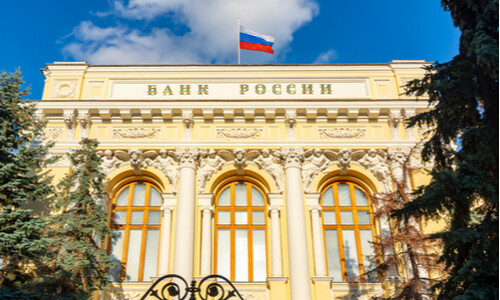Following Russia’s military intervention in Ukraine in 2022, the United States and its allies imposed sanctions that froze approximately $300 billion in sovereign Russian assets held in the West. With tensions escalating, the United States has proposed that working groups from the Group of Seven (G7) nations explore avenues to seize these funds, prompting concerns about the potential repercussions and legal challenges.
Central Bank Reserves:
The frozen assets predominantly comprise the reserves held by the Russian central bank. Like other central banks, Russia allocated a portion of its gold and foreign exchange reserves in liquid assets, including major currencies, gold, and government bonds. Approximately half of these reserves were held in the West. The frozen assets, valued at $300 billion, represent a substantial portion of Russia’s total foreign currency and gold reserves, which stood at $612 billion at the time.
Russian President Vladimir Putin has characterized the freezing of these reserves as theft, alleging that the West has initiated an economic war against Russia.
Central Bank Governor Elvira Nabiullina faced criticism from nationalists for allowing such a significant portion of the bank’s reserves to be frozen.
Nature of Frozen Assets:
While the Russian central bank has not provided a detailed breakdown of the frozen assets, preliminary information from early 2022 indicates a diverse portfolio. The central bank held around $207 billion in euro assets, $67 billion in U.S. dollar assets, and $37 billion in British pound assets. Additional holdings included Japanese yen ($36 billion), Canadian dollars ($19 billion), Australian dollars ($6 billion), Singapore dollars ($1.8 billion), and Swiss francs ($1 billion).
These assets were primarily invested in foreign securities, bank deposits, and nostro correspondent accounts. Notably, the bank’s significant bond holdings included sovereign bonds from China, Germany, France, Britain, Austria, and Canada. Russia’s gold reserves were held domestically, and investments in yuan were kept in China.
How Were the Assets Held:
Russia’s central bank did not employ complex nominal holders, making it relatively straightforward to identify the frozen assets. Most of these assets, including those belonging to private Russian citizens, were frozen at depositaries.
Confiscation Concerns:
Russian officials have vehemently opposed the idea of asset confiscation, emphasizing that such actions contradict the principles of free markets. There are warnings that if Russian assets are confiscated, foreign investors with assets in special “type C” accounts in Russia could face a similar fate.
Finance Minister Anton Siluanov revealed that there are significant funds in these “C accounts,” suggesting an amount comparable to the $300 billion of Russian reserves frozen in the West.
Kremlin spokesman Dmitry Peskov has stated that Russia would challenge any confiscation in the courts, emphasizing the sanctity of private property rights. The potential for a tit-for-tat response remains, with the fate of foreign investors’ assets in Russia hanging in the balance.
As the situation unfolds, the global financial community closely monitors developments, recognizing the intricate web of geopolitical and economic consequences tied to the frozen Russian reserves in the West.
















